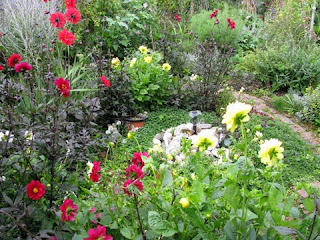Next, here are the photos of a small town garden, as described in the magazine October issue. Notice plants and fruit trees are mixed together.
Garden Notes, October. Planning a Small Garden
August, when
writing this, has been a mix of warm and wet. The weeds at least have thrived.
By October we look to asters to give us later colour, with perhaps some leaves
turning red for a late show. In planning for spring we should be buying in and
planting spring bulbs, such as daffodils and tulips. Tidying up borders there
will be clumps that can be divided into three or four and provide presents for
friends. The plant is healthier for this since middle dies back and the vigour
goes to the edge: dividing removes the tired middle. It is also time for
trimming hedges now that bird nesting has finished.
The main aim of
this article is planting a small garden. Our own garden is quite large but is
broken up in ten or so small gardens. I have looked for inspiration, for me as
well as you, at Ruth’s small garden in Old Town which is stuffed to the gunnels
with plants that flower all read rounds in rotation. Photos can be found in the
link below. The garden measures 16foot wide (around 5 metres) and 70foot long,
a typical long and thin terraced house garden. You go out of the back door to a
patio, with a boundary wall to one side and a fence the other. There are hedges
but don’t be tempted to put in privet or anything that has no all year
interest, or anything that will grow out of control. Lots of flowering shrubs
can be used for hedging, staggering the flowering across the year. This garden
has a recycled miniature gauge railway track alongside the path which came from
Southend Pier. Ruth once ran Thomas the
Tank down the track. At the bottom is a garage and a little path leading to the
back gate.
Every season of
the year the garden is a mass of colour as plants intermingle. It is a true
cottage garden, where there is no room for weeds with flowing plants densely
packed. As I write this the owner has sent photos of what is in flower in early
September, much of which will be still flowering in early October. I need to
add that it has been well established over the past thirty years and more or
less looks after itself, the owners are in their 70s. The garden is a
microclimate, kept frost-free since the buildings, walls and shelter retain
heat. This is the city effect where temperatures are several degrees higher than
in the country. This can be mimicked in small gardens, especially where there
is a courtyard feel. They have planted
apple trees along the garden and among the beds. Similarly there is a useful
herb garden and runner bean wigwams. So
in early September I can see roses, cosmos, dahlias, penstemon and pink
Japanese anemones in profusion. The
roses are long flowering varieties that don’t need pruning, the dahlias can
stay in the ground without protection since frost will not be severe, penstemons
just need a light prune in spring when bottom growth has begun. Sprinkle seed thinly
each spring, and it becomes a riot of colour by summer and autumn. I cut
Japanese anemones down to the bottom in November (actually I just pull them
right out to stop them being thugs. They
will grow again next year). I haven’t yet mentioned fuchsias. We are used to
tender fuchsias that need frost protection or replacing every year. You can
take cuttings (see below) but it is a balance between paying for winter heating
or spending less on plants grown on industrially. I regard tender fuchsias as
annuals and just throw them away. Consider hardy fuchsias which can overwinter
in the garden, without leaves, and green up in spring. The spirit of this
garden is to pack in plants which flower in winter, spring, summer and autumn.
Consider Christmas box and clematis Freckles for winter, spring bulbs and
philadelphus (mock orange) in spring, summer free-flowering roses, shrubs like
exotic yellow buddleias which give four months of flower. Try perennial
sunflowers (helianthus) which vary between two foot and eight.
Cuttings. I will keep a pot of cuttings of better
quality fuchsias in the house to use free heating. You can get thirty in one
large pot. Use 12, 10 and 8 inch plastic pots (you will need two 12 inch). Mix
multipurpose and commercial topsoil . Put a little in the bottom of the 12
inch, place the 10 inch in and surround it with the mix, do the same with the 8
inch and finish off with a small pot in the centre. Prepare four inch long
fuchsia twigs trimmed under a leaf joint (remove all leaves from the bottom two
inches) and push them firmly into the mix between the pots. Do the inner circle
first. Water, place a plastic bag over fairly tightly and secure it into the
extra 12 inch pot. See my pictures. Place in a cool frost-free place with some
light (utility room, garage, bedroom). Check them in March when you can pot
them on. The multiple pots act as root-trainers. You can do the same with hardy
plants, which can stay outside.
Stephen Bigger, Roman Court, Hunts
Hill. Blog: https://romancourt365.blogspot.co.uk
.













No comments:
Post a Comment